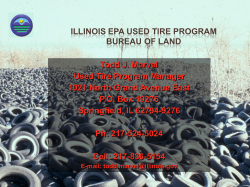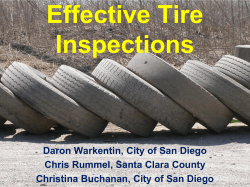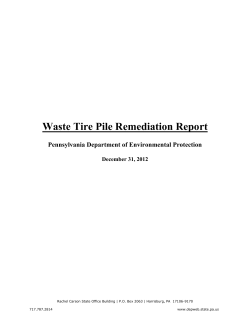
What is Tire Uniformity?
Table of Contents Tire Uniformity What is Tire Uniformity? Tire Uniformity is: D Actually “Non-Uniformity” D A quantitative measure of variation within a tire D Usual variations are in forces and runouts Axis System To measure tires, the tire industry uses an axis system which bisects the tire center. Forces are measured along these axes: D Fz = Radial Force D Fy = Lateral Force D Fx = Tangential Force Z Center of Tire X Y X Y Z Figure 3-1 Axis Measurement System 3-2 Introduction January 2001 Model B, Rev 1 Table of Contents Tire Uniformity Radial Force (Fz) D Z The vertical force between the tire and the road (or loadwheel on the ASTEC Machine). The Radial Axis is perpendicular to the road. This is the axis where radial force (Fz) is applied to the tire. Z Fz (Load) Figure 3-2 Radial Axis Lateral Force (Fy) D The side-to-side force along the rotation axis between the tire and the road (or loadwheel of the ASTEC Machine). Y The Lateral Axis is where side-to-side forces (Fy) are applied to steer the vehicle. Y Fy (Steering Forces) Figure 3-3 Lateral Axis Introduction 3-3 Table of Contents Tire Uniformity Tangential Force (Fx) D The driving force between the tire and the road (or loadwheel on the ASTEC Machine.) X The Tangential Axis is parallel to the road, in the direction of travel. This is the axis where the driving force (Fx) is applied to the tire. X Fx (Driving Force) Figure 3-4 Tangential Axis Moments Steering Moment (Mz) Z D The moment that induces steering pull D Also called aligning torque Motion of Tire About the Z Axis This is the torque that aligns the steering wheel back to the center after a turn. Z Figure 3-5 Steering Moment (Mz) 3-4 Introduction January 2001 Model B, Rev 1 Table of Contents Tire Uniformity Rolling Resistance Moment (My) D The moment that resists tire rotation Y Y Motion of Tire About the Y Axis Figure 3-6 Rolling Resistance Moment (My) Overturning Moment (Mx) D The moment that induces camber This moment would tend to make a tire tip over on its side. X X Motion of Tire About the X Axis Figure 3-7 Overturning Moment (Mx) Introduction 3-5 Table of Contents Tire Uniformity Force Variations Force Variation is the change in the forces as the tire rotates. The change in force is due to inconsistencies in tire manufacturing. Radial Force The ASTEC Machine measures two types of force variation: D Radial Force Variation D Lateral Force Variation Note: There must be a load on the tire to generate any force variation. Radial and lateral force variations are measured in both directions (clockwise and counterclockwise). Lateral Force Figure 3-8 Force Parameters Measured Radial Force Variation D Once the tire is inflated, loaded and rotating, the radial force becomes periodic. See Figure 3-9. D There is only a slight difference in radial force variation when the tire is rotated in either direction. One Rotation +10 Volts (+2500 lbs.) 0 Volts (0 lbs.) 1st Dir. 2nd Dir. Spindle Direction Change Figure 3-9 Radial Force Variation 3-6 Introduction January 2001 Model B, Rev 1 Table of Contents Tire Uniformity Lateral Force Variation D Once the tire is inflated, loaded and rotating, the lateral force variation becomes periodic. See Figure 3-10. One Rotation +10 Volts (+1250 lbs.) 1st Dir. 0 2nd Dir. -10 Volts (-1250 lbs.) Spindle Direction Change Figure 3-10 Lateral Force Variation Lateral Shift Variation D Typically, a positive lateral shift in the clockwise direction (1ST DIR), becomes a negative lateral shift in the counterclockwise direction (2ND DIR). This statement is true if the absolute value of plysteer is more than the absolute value of conicity. Introduction +10 Volts (+1250 lbs.) 1st DIR LSCCW The average lateral force in one direction. (See above paragraphs.) LSCW D 0 2nd DIR -10 Volts (-1250 lbs.) Figure 3-11 Lateral Shift Variation 3-7 Table of Contents Tire Uniformity Conicity D Is a lateral force defined as lateral shift clockwise plus lateral shift counterclockwise divided by 2. D Tire rolls like a cone. D Used as an indicator of steering pull. D Caused by off-center belt (about 30 N/mm of offset). D Force is exerted in the same direction, clockwise or counterclockwise. Counterclockwise Rotation Lateral Force Clockwise Rotation Figure 3-12 Conicity Plysteer D 3-8 Belt Ply Cords Is a lateral force defined as lateral shift clockwise minus lateral shift counterclockwise divided by 2. D Plysteer force depends on direction of rotation. D “Crab Walk” effect. D Does not affect ride performance. D Result of belt ply angles. D Outer-most ply has the dominant effect. Counterclockwise Rotation Plysteer Force Introduction ÌÌÌ ÌÌÌ ÌÌÌ ÌÌÌ ÌÌÌ ÌÌÌ ÌÌÌ ÌÌÌ ÌÌÌ Clockwise Rotation Plysteer Force Figure 3-13 Plysteer January 2001 Model B, Rev 1 Table of Contents Tire Uniformity Harmonic Analysis Force variation is a complex waveform. See example in Figure 3-14. Fourier analysis expresses the complex waveform as the sum of multiple sine waves, or harmonics. Each harmonic is defined by an amplitude and phase angle. Figure 3-15 is a Fourier analysis of the complex waveform in Figure 3-14, broken into four harmonics. The sum of these four harmonics approximate the original waveform. Force Variation Waveform Tire Rotation 0_ Figure 3-14 Force Variation Waveform First Harmonic A force variation waveform can be broken down into an infinite number of harmonics. Second Harmonic Waveform Fourth Harmonic Harmonic Computation 360_ Third Harmonic Figure 3-15 Harmonic Analysis The ASTEC Computer can compute the first through the tenth harmonic. Both the harmonic amplitudes and angles are available in the TIGRE Program (see Chapter 9). Note: Generally, the first and second harmonics of force variation influence the ride quality of a vehicle the most. Introduction 3-9 Table of Contents Tire Uniformity Geometry Variations Free Radius D Radius between the tire center and outside diameter when unloaded. Free Radius Figure 3-16 Free Radius Loaded Radius D Radius between tire center and road (or Loadwheel) when loaded. Note: A typical loaded radius is an inch and a quarter less than an unloaded radius. Loaded Radius Figure 3-17 Loaded Radius 3-10 Introduction January 2001 Model B, Rev 1 Table of Contents Tire Uniformity Runout Probe Radial Runout D Variation in the free radius Runout refers to the variation in roundness, or change in distance from the center of the tire outward to the tread, as the tire is rotated. Runout High (Point A) Runout Low (Point B) Out Of Round Tire Runout Graph Distance A +20 -20 B 0 Degrees 360 Figure 3-18 Radial Runout Lateral Runout D Variation in sidewall geometry while inflated, loaded and rotating. Figure 3-19 Lateral Runout Introduction 3-11 Table of Contents Tire Uniformity Bulge/Depression Measurement D Sidewall geometry variation running in radial direction. D Weak spots in the tire due to a lack of cord material. D Result of the sidewall splice overlap, gap overlap or misalignment. D Also caused by defects in calendared fabric in sidewall ply. Figure 3-20 Bulge Quality Control D Goal of every tire manufacturer is to make as many tires as possible with acceptable force variations. D Process variations are so large that most tire makers verify force variation by 100% inspection. Bivariate Normal Distribution Curve Force variation exhibits a bivariate normal distribution curve, bounded by zero. See Figure 3-21. D Much longer and higher tail. D Significant number of tires do not meet specifications because of force variations or other uniformity problems. 100 Percent of tires with specified force variation D Good Tires Cutoff Point for Acceptable Tires Bad Tires 0 0 4 9 13 daN of force variation 18 Figure 3-21 Bivariate Normal Distribution Curve 3-12 Introduction January 2001 Model B, Rev 1 Table of Contents Tire Uniformity Grinding Rubber Removed to Reduce Footprint Why grind? D Grinding increases production yield. D Grinding reduces scrap. D A 5% gross profit means you must sell 20 good tires to pay for one scrapped tire. D Force variation may be corrected by changing the footprint. Force Correction using Shoulder Grinding D Reduces the footprint area by reducing tread width, at the point of high force variation. See Figure 3-22. Figure 3-22 Shoulder Grinding Force Correction using Center Grinding D Reduces the footprint area by reducing tread length, at the point of high force variation. See Figure 3-23. No Rubber Removed Rubber Removed to Reduce Footprint ÁÁÁÁÁ ÁÁÁÁÁ Figure 3-23 Center Grinding Introduction 3-13
© Copyright 2025









